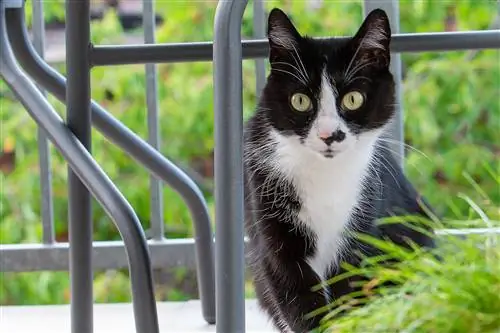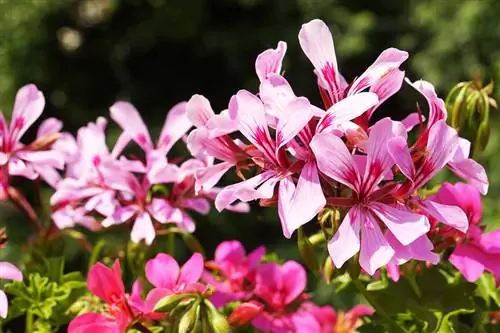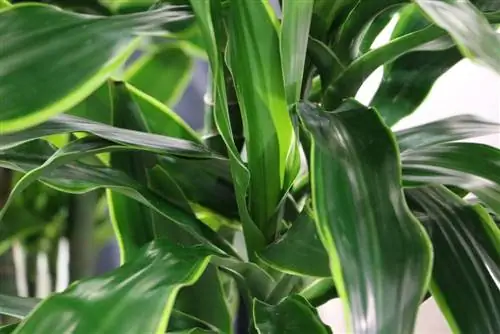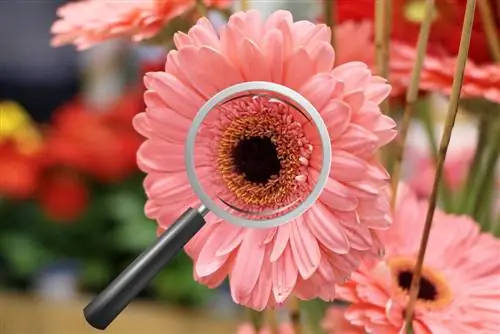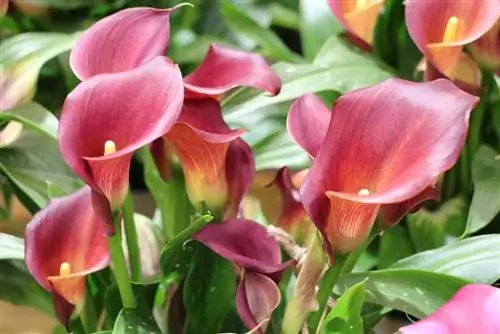- Author admin [email protected].
- Public 2023-12-17 03:39.
- Last modified 2025-10-04 22:41.
If you share an apartment with a cat, you should not have poisonous houseplants, as cats occasionally eat the greenery. There are many cat-friendly houseplants that are safe and can recover quickly if they are nibbled by a cat.
Houseplants with A
Mountain Palm (Chamaedorea)
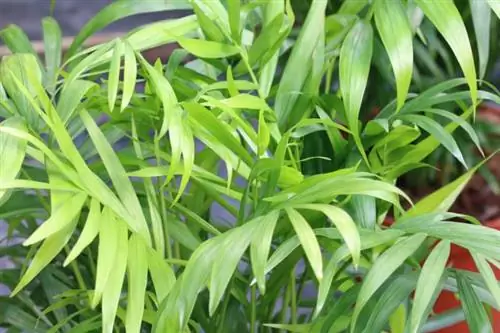
The mountain palm is a popular houseplant because its tolerance to lime makes it easy to water. Although mountain palms are not poisonous, they can cause digestive problems in cats with sensitive stomachs.
- Height: up to 200 cm
- Leaves: long-stemmed, pinnately
- Flowers: yellowish, inconspicuous spikes
- Location: semi-shaded to shady, suitable for the north side
- Substrate: palm soil
- Care: fertilize moderately, repot annually in spring
Cat-friendly plants with K
Camellia (Camellia)
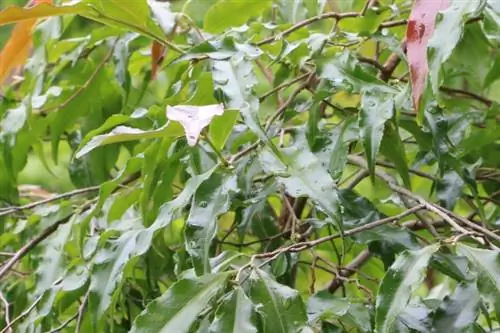
The most well-known camellia is the tea plant, which few people know belongs to this genus because it is rarely sold as an ornamental plant. What all camellias have in common is that they are non-toxic and their flowers exude an intoxicating scent.
- Height: up to 400 cm
- leaves: simple, oval, tapering
- Flowers: worry-dependent, white, reddish, multicolored
- Location: bright, no direct sun
- Substrate: Rhododendron soil
- Care: very sensitive to lime, prefers slightly acidic soil
Kentia palm (Howea forsteriana)
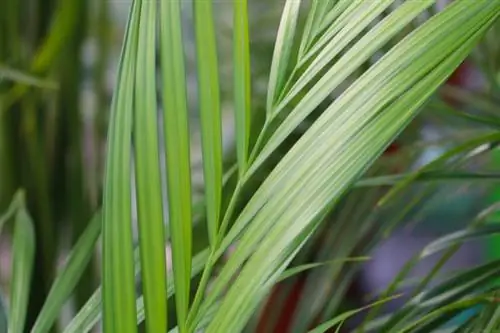
The Kentia palm is very robust. It is a houseplant that is cat-friendly because it is not poisonous and can easily be chewed.
- Height: up to 300 cm
- leaves: long-stemmed, pinnate
- Flowers: greenish, panicle-like, inconspicuous
- Location: gets by with little light, suitable for north-facing windows
- Substrate: Potting soil mixed with lots of sand
- Care: tolerates calcareous irrigation water well, needs high humidity
Tip:
The Kentia palm is the ideal plant for cats who like to nibble on green plants. It already looks a bit ruffled due to its fronds, which means that eaten leaves are hardly noticeable.
Calathea
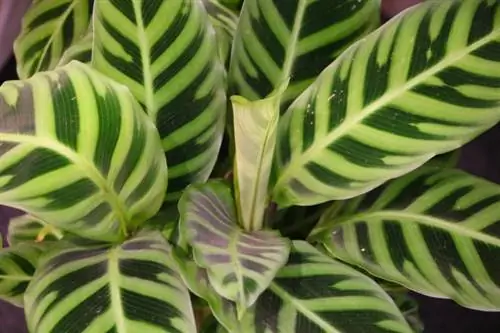
The basket marant is also known as arrowroot because an antidote to the poison dart frog toxin is obtained from its roots. However, the basket marante is a little more complex to care for as it likes it very warm and needs to be provided with the right amount of water.
- Height: up to 50 cm
- Leaves: lanceolate, broad, depending on the variety also multicolored
- Flowers: yellowish spikes
- Location: light to partially shaded
- Substrate: Potting soil
- Care: always keep slightly moist, use low-lime water, repot annually in spring
N - R
Nest fern (Asplenium nidus)
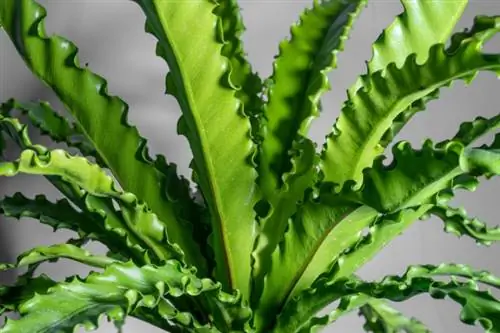
The nest fern is a houseplant that requires more effort to care for and, like most ferns, is cat-friendly. It needs temperatures of at least 20°C all year round.
- Height: up to 100 cm
- Leaves: lanceolate, strongly wavy
- Flowers: does not form flowers
- Location: partially shaded, no direct sun
- Substrate: slightly acidic, permeable
- Care: always keep slightly moist, avoid waterlogging
Slipperflower (Calceolaria)
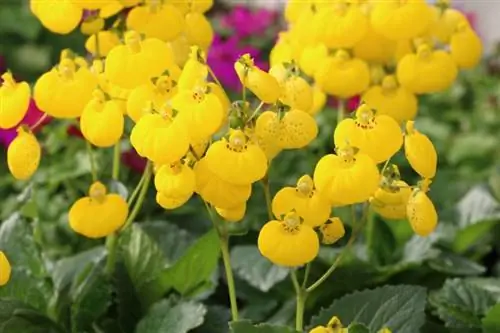
The slipper flower is a beautifully flowering houseplant that is cat-friendly. It is also called false orchid because of its flower shape, but compared to real orchids, it is not poisonous to cats.
- Height: up to 60 cm
- Leaves: oblong to oval
- Flowers: multicolored, yellow, orange, reddish
- Location: bright, no direct sun
- Substrate: Azalea soil
- Care: use low-lime water for watering, fertilize moderately
Passionflower (Passiflora)
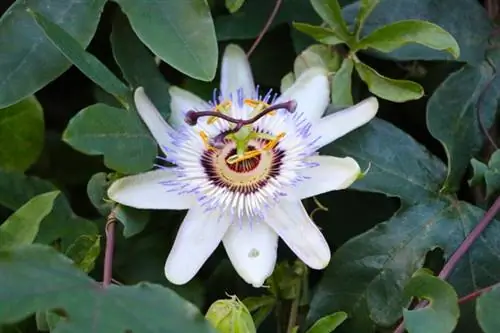
The passion flower is a fascinating plant in every respect that can be cultivated as a houseplant all year round. In addition to its climbing growth and impressive flowers, with a bit of luck it can even produce fruit.
- Height: up to 1000 cm
- Leaves: depending on the variety, palmate, lobed, heart-shaped
- Flowers: single or multicolored, almost all colors
- Location: bright, protected from drafts in winter, spray leaves occasionally with water
- Substrate: Potted plant soil supplemented with clay granules
- Care: Substrate should always be moderately moist
Columnea
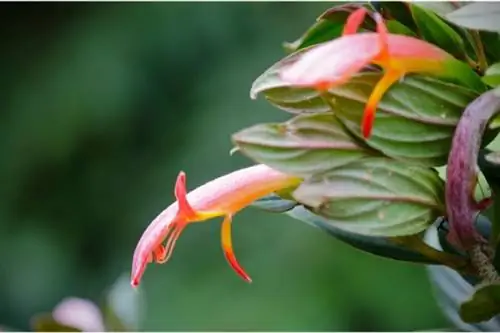
The throat vine is an ideal hanging plant. With good care, the cat-friendly houseplant produces very beautiful flowers.
- Height: up to 1000 cm
- Leaves: fleshy, dark green with reddish veins, egg-shaped, tapering
- Flowers: yellowish, reddish
- Location: bright, very warm, high humidity
- Substrate: Potting soil, mix with some clay granules or sand
- Care: to form flowers they need a cooling period of around 12°C for approx. two months
Cat Friendly Houseplants S
Shamflower (Aeschynanthus)
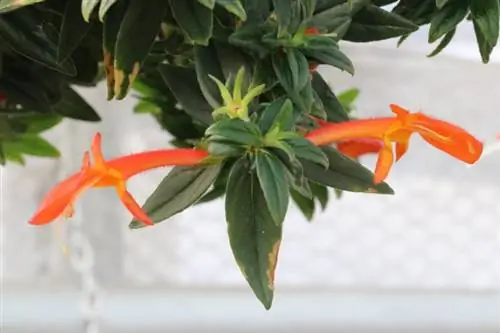
The pubic flower is an ideal hanging plant for the ceiling or for shelves. The intensely bright flowers are particularly attractive.
- Height: up to 120 cm
- Leaves: egg-shaped, tapering
- Flowers: yellow, red, orange
- Location: bright, no direct sun
- Substrate: cactus soil, potting soil mixed with sand
- Care: always keep slightly moist, use tempered water, fertilize moderately
Beautiful mallow (Abutilon)
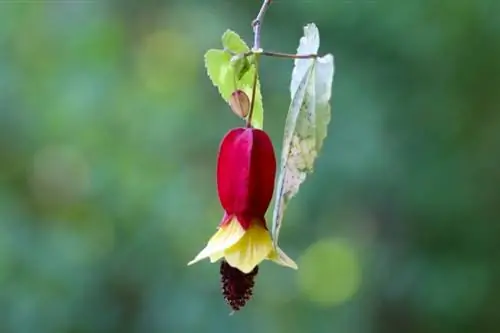
The beautiful mallow belongs to the mallow family, all of which are non-toxic to cats. The plants form a lush floral display that lasts for weeks.
- Height: up to 300 cm
- leaves: heart-shaped, wide
- Flowers: white, yellow, pink, red
- Location: bright, no direct sun
- Substrate: Potting soil
- Care: high water requirements in summer, use tempered water, fertilize regularly every 2 - 3 weeks
Tip:
As a houseplant, the beautiful mallow looks particularly decorative when trained to form small standard stems. The advantage is that the flowers and leaves are then at a height that is less attractive to cats.
Cobbler palm (Aspidistra)
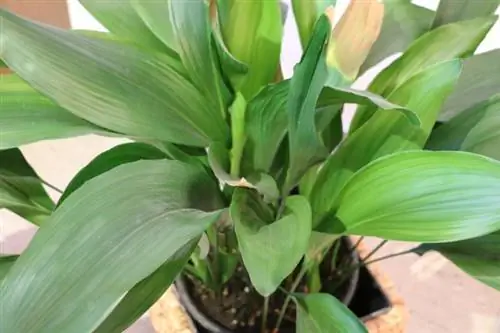
The cobbler palm is cat-friendly because the houseplant is absolutely robust. Regardless of whether she has been eaten or only receives moderate care, she is almost impossible to kill.
- Height: up to 80 cm
- Leaves: broad, petiolate, tapering
- Flowers: whitish to brownish, individual bells
- Location: gets by with less light, is suitable for the second row of the window, suitable for north windows
- Substrate: Pot plant soil, possibly mixed with a little sand or clay granules
- Care: Avoid waterlogging, keep dry
Sword Fern (Nephrolepis ex altata)
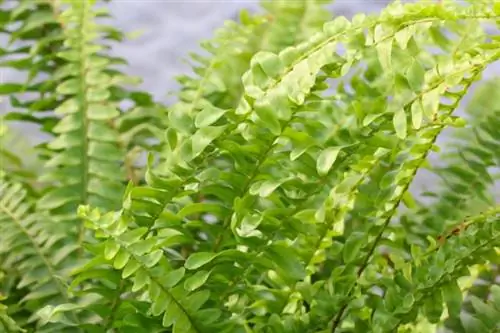
The sword fern is not only cat-friendly, but the ideal houseplant for the bathroom. She likes it warm and moist.
- Height: up to 55 cm
- leaves: elongated, pinnately
- Flowers: does not form flowers
- Location: bright, direct sun only in small amounts
- Substrate: nutrient-poor potting soil, alternatively a mixture of garden compost and leaf compost
- Care: do not use hard water
T - Z
Tapir flower (Crossandra infundibuliformis)
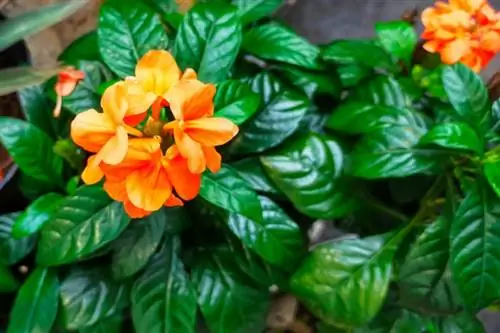
The Tapri flower is an eye-catcher thanks to its bright flowers. For a long time it was considered a very high-maintenance houseplant, but thanks to modern breeding, the amount of care required has been reduced.
- Height: up to 50 cm
- Leaves: dark green, broad, lanceolate
- Flowers: pink, orange
- Location: bright
- Substrate: Potted plant or potting soil
- Care: do not use hard water, in winter location with at least 20°C
Indoor bamboo (Pogonatherum paniceum)
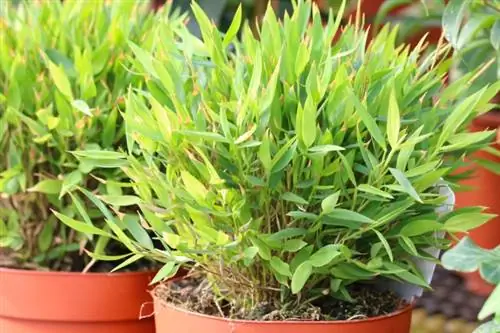
The indoor bamboo is also often sold in stores as chewing fun for cats. When purchasing, make sure that the plants are older, as young plants can be slightly poisonous.
- Height: up to 60 cm
- leaves: elongated, grass-like
- Flowers: yellowish, grape-like spikes
- Location: bright, warm, prefers high humidity
- Substrate: Potting soil
- Care: fertilize approx. every 14 days
Carpenter fir (Araucaria heterophylla)
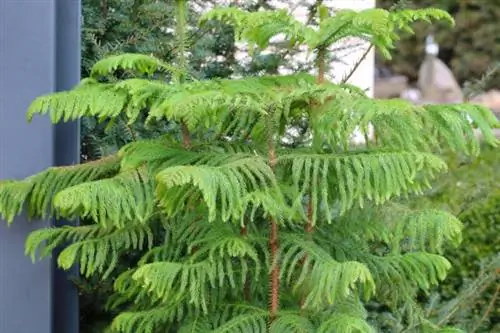
The indoor fir is offered as a living potted plant to the normal Christmas tree, especially around Christmas time. The frost-sensitive exotic is easy to care for and can even be grown from seeds.
- Height: up to 200 cm
- leaves: needle-like
- Flowers: reddish to brownish
- Location: bright, no direct sun
- Substrate: Rhododendron soil mixed with sand
- Care: always keep moderately moist, no hard water
Cyprus grass (Cyperus alternifolius)
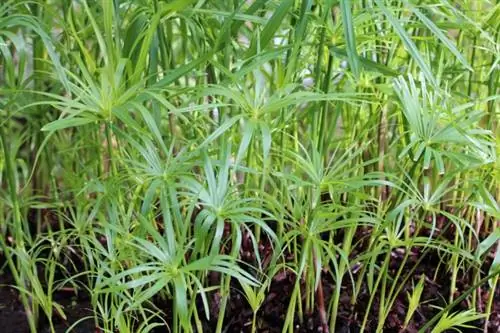
The Cyprus grass is very easy to care for and copes well with moisture. It is also often used to design terrariums.
- Height: up to 150 cm
- Leaves: elongated, slightly rough stalks
- Flowers: yellowish to brownish, conspicuous bracts
- Location: bright, warm, high humidity
- Substrate: Potting soil
- Care: There should always be some water in the planter
Frequently asked questions
Should eaten leaves be cut back?
If it is not a designated plant that cats are allowed to eat, you should cut back severely damaged plants. As a rule, it is more energy-saving for the plant if the leaves are removed about 2 - 3 cm above the leaf axis. This means that the effort required to remove the remaining leaves is significantly reduced. You do not need to cut back leaves that are only eaten at the edges. The plants often continue to grow without any problems if there is minor damage.
Are there plants that cats avoid?
No, there are no houseplant species that cats find repulsive. However, some cats react positively to plants such as catnip and are actually attracted to them. Providing cats with more attractive plants that they like can help lure them away from other houseplants and reduce the risk of them being damaged.
Do cats sharpen their claws on plants?
Yes, it can definitely happen that cats sharpen their claws on different types of palm trees. This often cannot be avoided and usually does not harm the plants as they can close the fine cracks themselves. If you want to prevent this, you should place a wire mesh around the trunk and offer the cat other opportunities to sharpen its claws.
Why are there sometimes different information about toxicity?
Almost all plants have a more or less high saponin content. Saponins are toxic to humans and animals in large quantities. There is not always precise information about the content, which is why some sources classify plants as toxic to cats, even if they only contain traces of saponins. Even small amounts are contained in plants designated for cats, such as cat grass. However, such small amounts pose no danger to cats.

